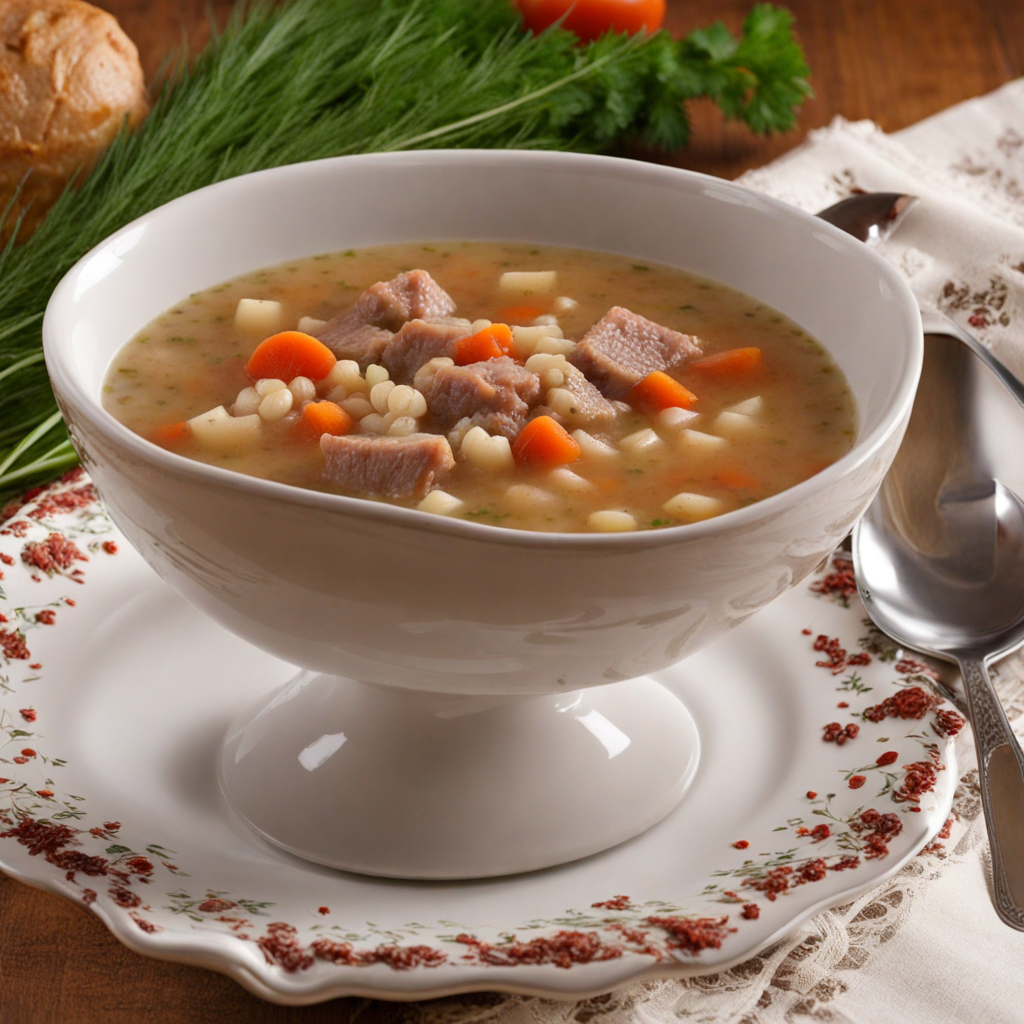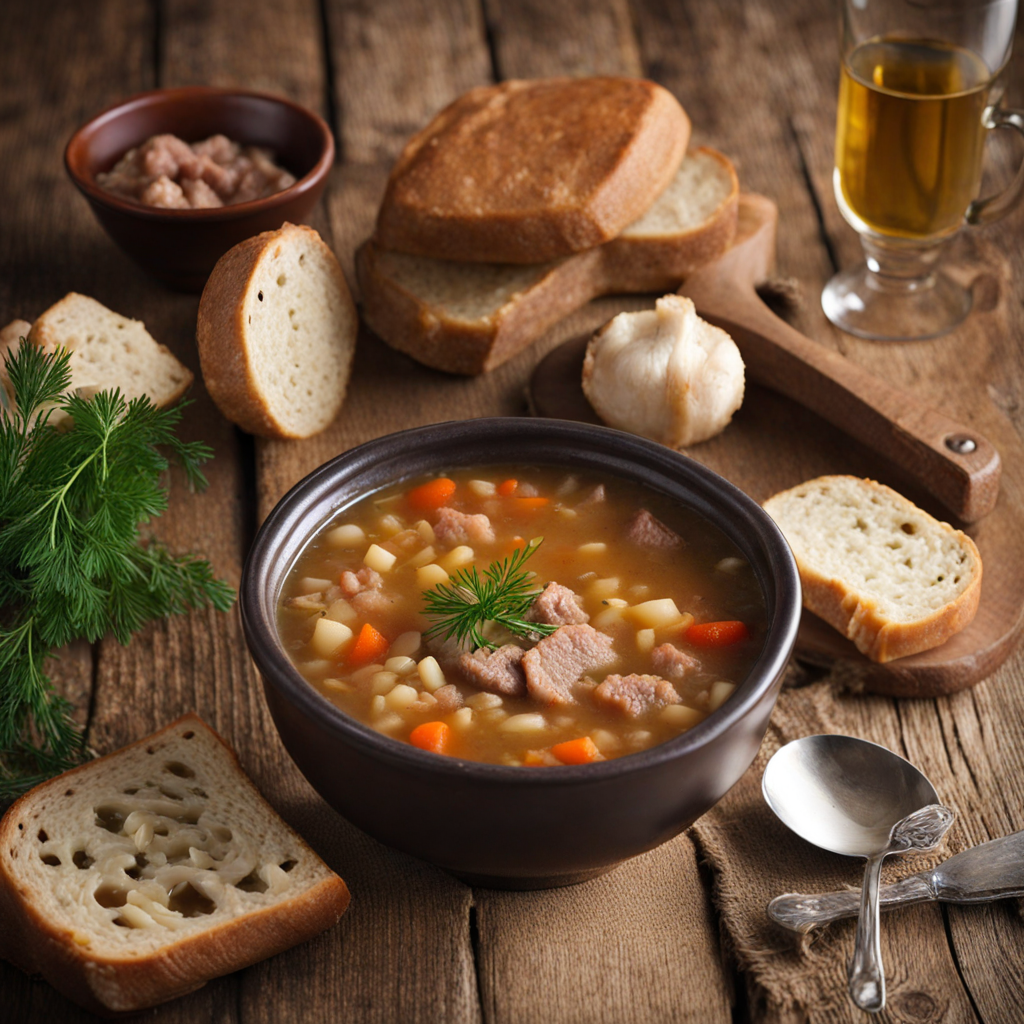Krupnik
Krupnik is a traditional Polish soup that holds a special place in the hearts and homes of many Poles. Its roots can be traced back to the medieval period, where it was often made by peasants as a nourishing and hearty dish. Historically, Krupnik was prepared using barley or other grains, which were readily available and provided sustenance. Over the centuries, this humble dish evolved, incorporating various regional ingredients and flavors, reflecting the diverse culinary traditions of Poland. The flavor profile of Krupnik is rich and comforting, often described as earthy and wholesome. The main ingredient, usually barley, imparts a slightly nutty taste that serves as the backbone of the soup. Depending on the recipe, the broth can be made from meat, such as chicken or pork, or it can be prepared as a vegetarian dish using a vegetable base. This versatility allows for a range of flavors, from the delicate sweetness of root vegetables to the savory depth of smoked meats. The addition of herbs, particularly dill and parsley, enhances the soup's freshness, making it a satisfying meal that warms both the body and soul. Preparation of Krupnik typically begins with the selection of key ingredients. The soup generally includes barley, which is often toasted to bring out its flavor, and a mix of vegetables such as carrots, celery, and onions. Meat, if used, is usually diced and browned before being added to the pot. The grains are simmered in a flavorful broth, allowing them to absorb the various
How It Became This Dish
The History of Krupnik: A Polish Culinary Treasure Krupnik, a hearty and comforting soup, holds a cherished place in Polish cuisine and culture. Its name derives from the Old Slavic word “krupa,” which refers to groats or grains, indicating the soup's foundational ingredients. As we delve into the history of Krupnik, we’ll explore its origins, cultural significance, and development over time, revealing how this humble dish has woven itself into the fabric of Polish life. #### Origins The roots of Krupnik can be traced back to the early medieval period in Eastern Europe, where grains played a vital role in the daily diet of the Slavic peoples. The use of barley, wheat, and rye was common, and these grains were often ground into coarse flour or left whole, forming the basis of various dishes. Krupnik likely emerged as a way to utilize these grains, combined with local herbs, vegetables, and meat, crafting a nutritious meal that could sustain families through harsh winters. The earliest written records of Krupnik date back to the 15th century, although it certainly existed in oral tradition long before then. Historical texts from the period indicate that Krupnik was not just a simple soup but a dish that was often enriched with meat, especially during festive occasions. The inclusion of meat and spices turned what might have been a basic broth into a celebratory dish, reflecting the agricultural abundance and culinary creativity of the time. #### Cultural Significance Krupnik is more than just a dish; it is a symbol of Polish hospitality and warmth. Traditionally, it is served at gatherings, family celebrations, and during the colder months, embodying the spirit of togetherness. In Polish culture, food often plays a role in storytelling and tradition, and Krupnik is no exception. Grandmothers across Poland have passed down their unique recipes, each infused with family secrets and personal touches, making Krupnik a dish that connects generations. In rural areas, Krupnik is often associated with the harvest season. Farmers would prepare the dish to celebrate the fruits of their labor, using fresh ingredients from their fields. This connection to the land is significant in Polish culture, where food is seen as a reflection of the seasons and local agricultural practices. Moreover, Krupnik has spiritual connotations in Polish folklore. It is sometimes prepared during significant life events, such as weddings, christenings, or funerals, serving as a reminder of the cycle of life and the importance of community support during both joyous and difficult times. The dish embodies the warmth of home and family, offering comfort in times of need. #### Development Over Time As Poland experienced various historical changes—through partitions, wars, and cultural exchanges—so too did Krupnik. The dish adapted to include various regional ingredients and methods, reflecting the diverse influences that shaped Polish cuisine. In the 19th century, with the rise of industrialization and urbanization, Krupnik began to evolve further. Urban dwellers sought quick and nourishing meals, leading to variations that incorporated more readily available ingredients. The traditional recipes that called for long-cooked broths began to be simplified, making Krupnik accessible to a broader audience. However, despite these changes, the essence of the dish remained intact, serving as a reminder of home and heritage. Krupnik also found its way into Polish literature and art, where it was often depicted as a symbol of comfort and nostalgia. Authors and poets have referenced the dish in their works, evoking the warmth of home and family. This literary significance has helped to elevate Krupnik from a mere recipe to an emblem of Polish identity. In the 20th century, the diaspora of Polish immigrants around the world brought Krupnik to new shores. As Polish communities established themselves in places like the United States, Canada, and the United Kingdom, they carried their culinary traditions with them. Krupnik adapted once again, incorporating local ingredients while retaining its core elements. It became a dish that not only nourished the body but also served as a connection to one's roots, reinforcing cultural identity in a foreign land. #### Modern Interpretations Today, Krupnik continues to thrive in Poland and among Polish communities worldwide. While traditional recipes remain popular, modern chefs are experimenting with the dish, infusing it with contemporary twists. Ingredients such as quinoa, farro, or exotic spices have made their way into Krupnik, appealing to a younger generation that is eager to explore traditional foods in new ways. Moreover, the rise of the farm-to-table movement has sparked renewed interest in the use of local, seasonal ingredients. This trend aligns perfectly with the original essence of Krupnik, which celebrates the bounty of the land. Many restaurants in Poland now feature Krupnik on their menus, showcasing locally sourced produce and meats, thus honoring the dish's heritage while embracing modern culinary practices. Krupnik has also gained popularity beyond Polish borders. Food enthusiasts around the world are discovering its hearty flavors and comforting nature, leading to a resurgence of interest in Eastern European cuisine as a whole. Cookbooks and culinary blogs frequently feature Krupnik, highlighting its versatility and inviting home cooks to recreate this timeless dish. #### Conclusion Krupnik is more than just a soup; it is a reflection of Polish history, culture, and identity. Its origins in the Slavic tradition, cultural significance as a symbol of family and hospitality, and adaptability over time all contribute to its enduring popularity. As it continues to evolve in modern kitchens, Krupnik remains a beloved culinary treasure, bridging the past with the present and nourishing both body and spirit. Whether enjoyed in a quaint Polish village or a bustling city abroad, Krupnik serves as a warm reminder of home, heritage, and the power of food to bring people together.
You may like
Discover local flavors from Poland







